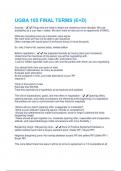Exam (elaborations)
UGBA 105 FINAL TERMS (E+D) Questions + Answers Graded A+
- Course
- Institution
Scarcity - ️️Things that are hard to obtain are viewed as more valuable. We use availability as a cue, less = better. We don't want to miss out on an opportunity (FOMO). Difficulty (including price) as a heuristic value signal We want what we may not be able to get reactance Often overlaps ...
[Show more]



